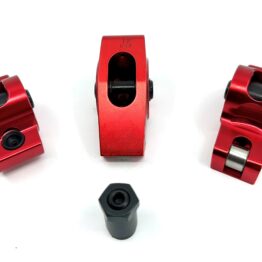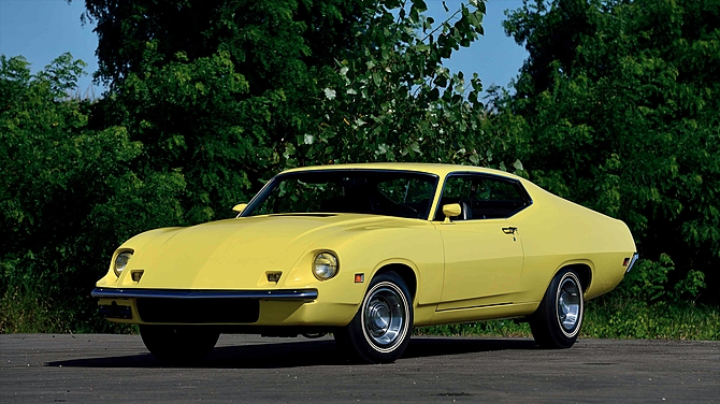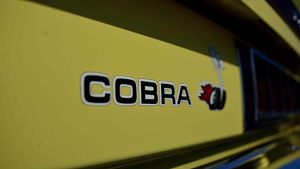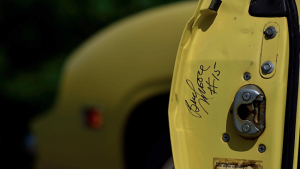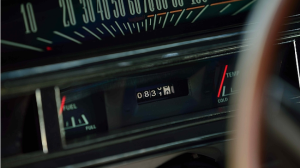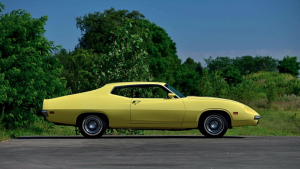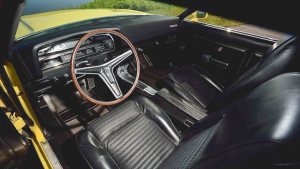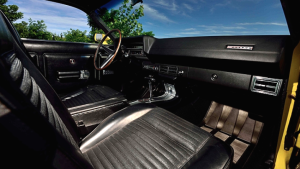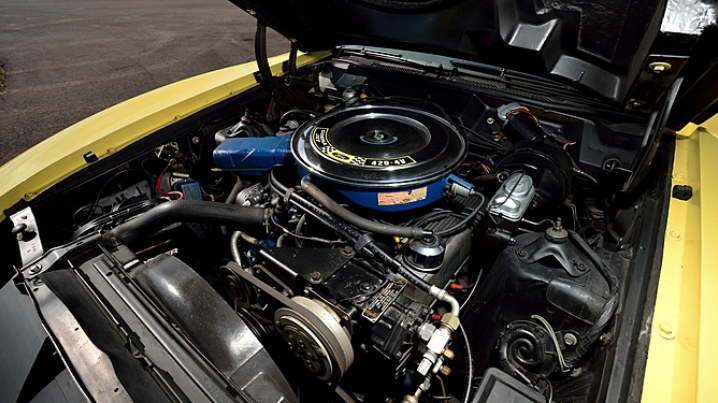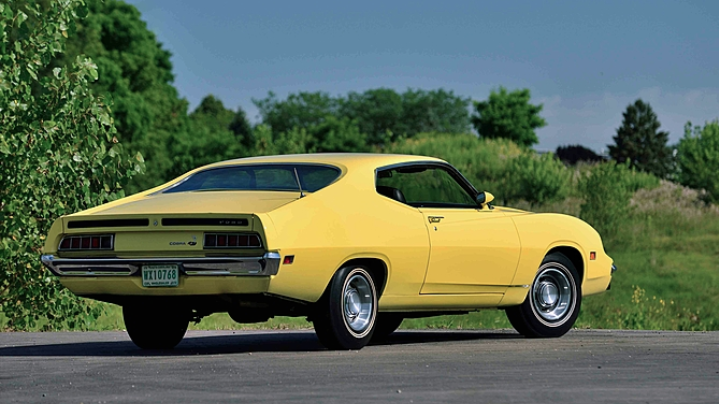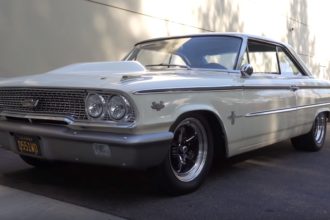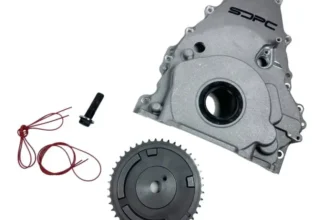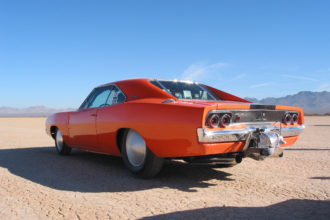photos by: Mecum Auctions
With so may enthusiasts coveting the Chevelles, GTOs and the Chargers, these days it just seems the Ford Torino is the underdog of the musclecar intermediates. We’ve seen the market for these cars go up and down over the last few decades, and they never have captured the market the way we would have liked them to. However, there’s always an exception to the rule and this ’70 Torino Cobra Jet is certainly it!
Set to cross the Mecum Auctions: Kissimmee block in January, this one-of-two (in this particular combination) NASCAR-inspired special is expected to bring in quite amount of cash, and hopefully, should help boost the values of these classic Ford intermediates. We have the entire history on this car, courtesy of Mecum, featured below:
“Designed to dominate the competition on NASCAR’s superspeedways, the Ford Torino King Cobra never made it to the grid, the victim of poor aerodynamics, budget cuts and corporate ennui. This Bright Yellow example, one of two known to exist today, was rescued from the crusher by Ford racing legend Bud Moore, and it represents a fascinating episode in the saga of the classic muscle-car era.
While Ford had won the NASCAR Manufacturer’s Championship every year from 1963 through 1968, the Total Performance team entered 1969 facing a new threat from Dodge in the form of the slippery Charger 500. Ford Racing Director Jacque Passino had trick new machines of his own in the form of the long-nosed Torino Talladega and its Mercury Spoiler II counterpart, and a stable of drivers that included David Pearson, Richard Petty, Cale Yarborough, and LeeRoy Yarborough. When the Charger 500 proved inadequate, Dodge responded with the aerodynamic Daytona, but it was not enough to defeat the equally slick Talladega, and Ford locked up the Championship for the seventh-consecutive time in 1969.
As planning began for the 1970 season, Passino faced trouble from within Ford’s styling department, whose design for the new Torino had serious inherent aerodynamic shortcomings. Specifically, the new deep-set front grille would trap air like a parachute, and while the windshield’s new laid-back profile was an improvement, air flowing over the roof created lift at the back as it passed the new concave rear window. Like practically everyone else in the world, Passino knew of Plymouth’s plans to adapt the Daytona’s knife-edged nose and towering rear wing to its Road Runner, and to face the double threat presented by Chrysler’s winged warriors, he instructed Ford’s Special Design Center director Larry Shinoda to devise a homologation-special aero treatment for the 1970 Torino.
Passino’s idea was to reshape the Torino’s nose along the lines of the Le Mans-winning GT40. With that in mind, Shinoda and Special Vehicles Engineering designers Chuck Mountain and Ed Hall got to work penning a new front clip that, like the Talladega, could be grafted onto the stock Torino body. The new nose arced steeply from the windshield down to a slim chromed bumper that would be mere inches above the ground in lowered NASCAR configuration, and extended the Torino’s length by more than half a foot, promising to cut through the air with ease. The only other modification under consideration was to roll the rocker panels, as had been done to the production Talladega and Spoiler II, to allow NASCAR chassis builders to legally lower the cars one inch over the frame for a lower profile.
As Shinoda and his team refined the details of the new nose, a small number of fiberglass copies were sent to Ford’s NASCAR teams for real-world testing, which soon exposed the concept’s basic flaw: lack of aerodynamic balance. The new nose planted the front of the King Cobra to the pavement with some 200 pounds of downforce, but that very effect exacerbated the vacuum created by the concave backlight, causing dangerously destabilizing lift at the rear. Cale Yarborough apparently encountered the phenomenon during testing in a Boss 429-powered Torino, experiencing unpredictable handling in the corners and spinning the rear tires along the full length of the straights. Countering the problem would take either an illegally high rear spoiler or a Daytona-type wing, but even as Shinoda et al were considering solutions, other forces were at work that would sink the King Cobra for good.
Firstly, Henry Ford II had just dismissed company president Semon “Bunkie” Knudsen, who had spearheaded Ford’s Total Performance racing program. Ford then announced vast cuts to the racing budget, including the King Cobra development program. Simple math took over from there; bean counters concluded that Ford would have to sell 3,000 King Cobras to return the projected $2,000,000 investment required to retool for production and homologation.
The King Cobra project was dead, but the story did not end there. Most Ford teams opted to use the previous year’s Talladegas and Spoiler IIs. Richard Petty’s team dropped work on its own King Cobra and inked a new agreement to run Plymouth’s new Superbird. Ford executives were using this King Cobra before its scheduled date with the crusher—the same fate met by most canceled project vehicles. Before that could happen, legendary Ford racecar builder and team manager Bud Moore was in Dearborn to close out his 1970 program and take delivery of three new 1971 Mustangs for his Trans Am program.
In a 1988 “Autoweek” interview, Moore related that the King Cobra was parked in a Dearborn garage next to the aforementioned 1971 Mustangs. Enchanted by the Bright Yellow car’s swoopy look, he asked that it be included in the agreement for the 1971 Trans Am program. When he left to return home to his Spartanburg, North Carolina, shop, the King Cobra left with him. Moore kept the car for the several decades, exercising it sparingly but regularly enough to keep it limber. The King Cobra was eventually sold to Ford collector Jacky Jones of Hayesville, North Carolina, then subsequently became part of the Brett Torino Collection in Las Vegas, Nevada. Today the car shows just 831 miles on the odometer and presents as it was the day it arrived in Spartanburg 45 years ago.
As a pre-production prototype, the King Cobra is not exactly identical to production specification. The front clip and hood are fiberglass rather than the steel pieces required for homologation, and the original Bright Yellow paint is devoid of the striping and Blackout treatments seen in contemporary design studio photos, which also show the prototypes wearing Magnum 500 wheels with wide Goodyear White-letter tires; the Bud Moore King Cobra rides on Cyclone GT wheels wearing double White-stripe G78 tires. Other than the rolled rocker panels and staggered shocks seen on the Talladegas and Spoiler IIs, it is virtually identical to the planned road-going version.
Ordered on August 18, 1969, by Ford Motor Company in Dearborn as a Special Purpose Vehicle, the car was produced at the Lorian, Ohio, assembly plant on September 15, 1969. Power comes from Ford’s racy 429 Cobra Jet V-8 engine, which cranks 370 HP and a hefty 450 lb-ft of torque through a console-shifted C6 3-speed automatic to a Traction-Lok rear axle. Although the fiberglass hood was fabricated with the pieces necessary to accommodate Ram Air induction, the air cleaner is a standard piece that draws air from the under hood area. Custom braces support a sheet metal duct that directs air to the radiator through the opening in the lower front valence, but the rest of the body, chassis and mechanicals are factory stock. In addition to power steering and power drum brakes, the King Cobra is sparingly optioned with air conditioning and power windows, tinted windshield, Comfort Weave bucket seats and center console, 3-spoke Rim Blow steering wheel, 120 MPH speedometer, pushbutton radio and a token barrel-scale tachometer.
It is a great boon to the muscle car culture that Bud Moore rescued the King Cobra from the crusher’s unyielding grip, and while it never turned a wheel in anger, it will always be emblematic of the outlandish creations Detroit spawned at the height of the classic muscle-car era. The only King Cobra with a production Torino Cobra serial number, it bears Bud Moore’s autograph just above the original manufacturer’s sticker on the back side of the driver’s door. Unrestored and showing just 831 miles, its extensive documentation includes the original invoice from Ford to Bud Moore Engineering, the original “as-is” bill of sale from Ford to Moore, a copy of the original MSO, South Carolina registrations in Moore’s name and South Carolina inspection receipts documenting the mileage, a 2008 bill of sale from Jacky Jones to Brett Torino, Marti Report, owner’s manual and owner card.” -Mecum Auctions
Vehicle Highlights:
- Unrestored with 831 original miles
- Three owners since new
- Formerly owned by Bud Moore, Jacky Jones and Brett Torino
- The only King Cobra with a production Torino VIN
- Documented with the original invoice from Ford to Bud Moore Engineering, the original as-is bill of sale from Ford to Moore, a copy of the original MSO, South Carolina registrations in Moore’s name and SC inspection receipts documenting the mileage, a 2008 bill of sale from Jacky Jones to Brett Torino, owner’s manual, owner card and Marti Report
- Featured in multiple magazine articles
- Original manufacturer door sticker intact
- The door jamb is autographed by Bud Moore
- 429/370 HP Cobra Jet engine
- Automatic transmission
- Factory air conditioning
- Power steering, brakes and windows
- An iconic preservation of Ford Racing history

Rick Seitz is the owner and founder of AutoCentric Media, the parent company to Timeless Muscle Magazine, and has a true love and passion for all vehicles. When he isn’t tuning, testing, or competing with the magazine’s current crop of project vehicles, he’s busy tinkering and planning the next round modifications for his own cars.






